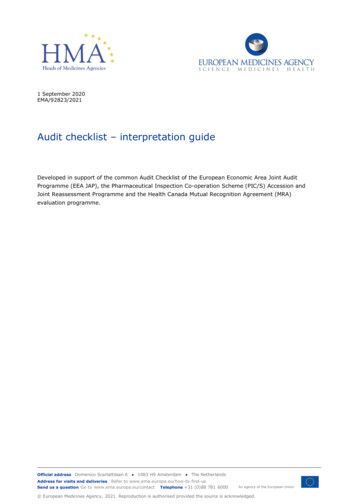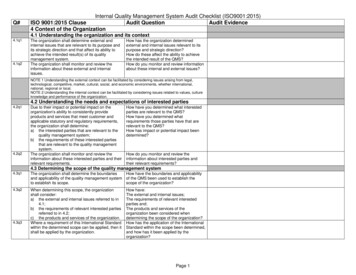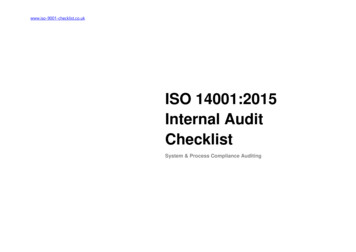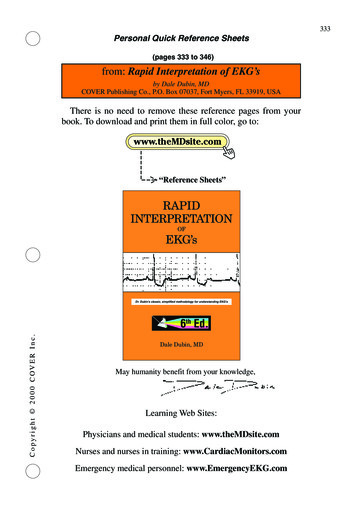
Transcription
1 September 2020EMA/92823/2021Audit checklist – interpretation guideDeveloped in support of the common Audit Checklist of the European Economic Area Joint AuditProgramme (EEA JAP), the Pharmaceutical Inspection Co-operation Scheme (PIC/S) Accession andJoint Reassessment Programme and the Health Canada Mutual Recognition Agreement (MRA)evaluation programme.Official address Domenico Scarlattilaan 6 1083 HS Amsterdam The NetherlandsAddress for visits and deliveries Refer to www.ema.europa.eu/how-to-find-usSend us a question Go to www.ema.europa.eu/contactTelephone 31 (0)88 781 6000An agency of the European Union European Medicines Agency, 2021. Reproduction is authorised provided the source is acknowledged.
MRA/JAP/PIC/S Audit Checklist* - Interpretation guidePurposeThe interpretations provided in this guide have been written with a view to facilitate the understanding ofeach indicator, to harmonise expectations and enhance consistency when proceeding with anassessment of a competent authority’s Good Manufacturing Practices (GMP) regulatory complianceprogramme. A GMP regulatory compliance programme is not limited to the GMP inspection process butalso includes components such as the supporting infrastructure of legislative and regulatoryrequirements, GMP standards, inspection/enforcement resources and procedures, performancestandards, alert and crisis system, analytical capability, surveillance programme and qualitymanagement systems.The term “Inspectorate” in the context of this document includes all organisational structures in chargeof any of the above listed components of a GMP regulatory compliance programme.Note that the scope of the evaluation, e.g. PIC/S Accession, PIC/S Joint Reassessment Programme (JRP),MRA evaluation, European Economic Area Joint Audit Programme (EEA JAP), will dictate the baselinestandard to be used in order to consider the indicator as fulfilled/equivalent.Product targeted by the evaluation is defined in the checklist’s glossary as Active PharmaceuticalIngredient (API), finished medicinal product, investigational medicinal products, or any intermediate.Background information:The GMP regulatory compliance programme checklist is based on 11 components and 38 subcomponents comprising a total of 78 indicators.-There are 8 sub-components considered critical, 14 sub-components considered as very importantand 3 sub-components are important (at the time of the creation of the checklist, 13 subcomponents were combined with other similar sub-components to facilitate the evaluation).-There are 48 indicators related specifically to the critical sub-components, 26 indicators for thevery important sub-components and 4 for the important sub- components.* See Audit ChecklistAudit checklist – interpretation guideEMA/92823/2021Page 2/57
INTERPRETATION GUIDEIndicatorDisclaimer: The content of this document should not be regarded as the only possible interpretation of the indicator, nor does it intend to cover every situation.Sub-component 1A Legislative and regulatory requirements and scope - Empowering legislation (Critical)1The legislation identifies key delegations and functions in the organisation(s)/ regulatory authority (ies) assigned foroverall responsibility for the GMP regulatory compliance programme.Interpretation:Documentation reviewThis indicator pertains to the Legal Status of the Authority or Authorities.- Verify if the legislation specifies an authority or authorities responsible for the regulation of medicines at national and/orregional level.- Verify that the legislation details the responsibilities of the authority or authorities with regards to key aspects of the GMPregulatory compliance programme.- If the authority under assessment is responsible for the regulation of both human and veterinary medicinal products, bothcompetencies should be evaluated.Evidence example:National legislation or official orders that have the force of law.If responsibility is shared between authorities, check that there are agreed arrangements in place that ensure the correctfunctioning of the GMP regulatory compliance programme.Audit checklist – interpretation guideEMA/92823/2021Page 3/57
INTERPRETATION GUIDEIndicator2The authority to designate inspectors is vested in legislation.Interpretation:Documentation reviewThe designation referred to in this indicator must be seen as assignment of an employee in the role of inspector. It is not related torecruitment of personnel.- Verify in the legislation that there is a provision for appointing inspectors and who is authorised to do so. The provision might be of ageneral character, e.g. that a Director General within the Government / civil service is authorised to designate staff members.- Written legal authorisation to appoint designate staff members should be in place.- The process for designation of inspectors is verified under sub-component 2A indicator 24.3The identity of designated inspectors and scope of jurisdiction of legislation are available to companies beinginspected.Interpretation:Documentation reviewAudit checklist – interpretation guideEMA/92823/2021Page 4/57
INTERPRETATION GUIDEIndicator- Verify that the inspector is required to produce, upon request by a company, the designation document and the scope ofjurisdiction of legislation.- Each inspector may have an ID pass/a written permit or any other form of designation document which signifies authority to carryout inspection on behalf of a competent authority.- The designation document (e.g. ID pass/ written permit or other form of designation) may contain information on the scope ofjurisdiction.- Inspected entities can verify the identity of the inspectors and the scope of activities when the information is in the publicdomain.Evidence examples: Select individual records of a few inspectors for review among the list of designated inspectors4There is legal authority for an inspector to enter at any reasonable time in any place where active pharmaceuticalingredients and / or medicinal products are manufactured, imported and exported.Interpretation:Documentation review- Verify in the legislation that there is a provision allowing inspectors to access, at any reasonable time, places where manufacturing,packaging, storage, testing, importation and exportation activities are conducted.Audit checklist – interpretation guideEMA/92823/2021Page 5/57
INTERPRETATION GUIDEIndicator- There may be cases where inspectors are physically prevented from carrying out the inspection, and may request the help of a lawenforcement group (e.g. police or customs department). This situation should be addressed in the legislation or there should be articlesin the legislation empowering the said group. Cooperation between the two concerned organisational structures should be defined inappropriate documentation.5There is legal authority for taking samples and submitting them to designated laboratories.Interpretation:Documentation review- Verify in the legislation that there is a provision that allow inspectors to take samples, at any reasonable time, in any place wheremanufacturing, packaging, storage, testing, importation and exportation activities are conducted. The sample taken may be submittedto a laboratory designated by the competent authority for official testing.- The samples in this indicator should not be confused with samples mentioned under sub-component 10A indicators 66 and 67, wheresampling is related to the market surveillance programme.Evidence examples: national legislation, competent authority written procedures relating to sampling and sending them todesignated laboratories.6There is legal authority for obtaining evidence such as documents, photographs/videos of premises and equipment.Interpretation:Documentation reviewAudit checklist – interpretation guideEMA/92823/2021Page 6/57
INTERPRETATION GUIDEIndicator- Verify that there is a provision in the national legislation for inspectors to request, view and assess materials at site or to take theoriginals or copies away, in order to verify compliance with GMP.- The provision for this may be in the national medicines legislation or it may be in other national legislation, e.g. to allow a lawenforcement representative (e.g. police or customs officer) to accompany the inspector to obtain these materials.- There should also be provision for actions which the inspector or competent authority can take in situations where the site does notprovide the materials following reasonable request by the inspector.- The process for how to deal with these situations should be in a written procedure (may need to link this to the correct handling ofmaterials, possibly as evidence).Evidence examples: national legislation, competent authority written procedures relating to obtaining manufacturer’s batch manufacturingdocuments and other written or electronic records or to take photographs or videos.7There is legal authority to open and examine any article subject to legislation.Interpretation:Documentation review- Verify that the national legislation provides the right to the designated inspectors to open and examine any article (e.g.medicinal products, APIs, packaging materials, etc.) subject to legislation.Audit checklist – interpretation guideEMA/92823/2021Page 7/57
INTERPRETATION GUIDEIndicatorEvidence example: related pieces of the national legislation.8There is the legal authority to seize or detain any article believed to be in violation.Interpretation:Documentation review- Verify in the legislation that there is a provision allowing inspectors to seize or detain any article (e.g. medicinal products, APIs,packaging materials, etc.) connected with an offence or to prevent offences (in particular at places where manufacturing, packaging,storage, testing, importation and exportation activities are conducted) where there may be non-compliance with GMP.- There may be cases where inspectors are not allowed to seize or detain articles and may request the help of a law enforcement group(e.g. police or customs department). This situation should be addressed in the legislation or there should be provisions empowering thelaw enforcement group. Cooperation between the two concerned organisational structures should be defined in an appropriatedocumentation.The seizure procedures/mechanisms and records are to be assessed under sub-component 7B indicator 55.9The legislation allows entry to a private dwelling.Interpretation:Documentation reviewAudit checklist – interpretation guideEMA/92823/2021Page 8/57
INTERPRETATION GUIDEIndicator- Verify if the legislation allows entry to the private dwelling when required such as when suspected illegal manufacturingoperations occur.- This may not necessarily be in the medicines legislation but in other national legislation. In some instances, the help of a lawenforcement group (e.g. police or customs department) may be requested. Cooperation between the two concerned organisationalstructures should be defined in an appropriate documentation.10Legislation requires that the person who has the responsibility of the site where active pharmaceutical ingredients andmedicinal products are manufactured, imported and exported, to cooperate and not obstruct an inspector.Interpretation:Documentation review- Verify in the legislation that the person, who has the responsibility for the site where active pharmaceutical ingredients and / ormedicinal products are manufactured, imported and exported, have to cooperate and not obstruct an inspector.- The “person” could be also indicated as the authorised manufacturer, Senior Management, the person designated for quality or anyother legal person with GMP responsibilities.- There may be cases where this provision is not specifically addressed in the national legislation. In this case, the auditor should evaluateif the same principle is addressed in a different way in the legislation and if the approach provides the inspector with an equivalent level ofcooperation.Audit checklist – interpretation guideEMA/92823/2021Page 9/57
INTERPRETATION GUIDEIndicator11Legislation requires a marketing authorisation holder and/or a manufacturer of medicinal product to report to theregulatory authority any serious adverse medicinal product reactions.Interpretation:ContextThis indicator has originally been added to the audit checklist to address the requirement included in the MRA agreement Appendix 4under component 10-Surveillance programme; “Adverse reaction reporting system/procedures” but, as specified under sub-component10D-Adverse reaction reporting system/procedures are not to be evaluated as they are not considered within the scope of a GMPregulatory compliance programme. It is considered as an element of a Pharmacovigilance programme. However, it is expected that thelegislation includes a requirement for the marketing authorisation holder and/or the manufacturer to report any serious adversereaction.Documentation review- Verify that there is a provision in the legislation for the marketing authorisation holder and/or the manufacturer to report seriousadverse drug reactions (ADRs).- In the situation where the ADR is due to a quality defect, it is expected that the competent authority does the appropriate follow- upwith the manufacturer on possible GMP deficiencies.- An adverse reaction to a defective medicinal product may also result in a complaint. The competent authority should proceed with aninvestigation and take the appropriate actions. The consumer complaint procedure/system and records are assessed under the subcomponent 10C.Audit checklist – interpretation guideEMA/92823/2021Page 10/57
INTERPRETATION GUIDEIndicator12Legislation requires the marketing authorisation holder and a manufacturer of active pharmaceutical ingredients ormedicinal product to assess, investigate and document any product defect impacting quality.Interpretation:Documentation review- Verify that there is a provision in the legislation that stipulates that any complaint or information received concerning a quality defectshall be recorded and investigated by the marketing authorisation holder and the manufacturer of active pharmaceutical ingredients ormedicinal product. Note that this indicator does not pertain to the reporting of product quality defects to the competent authority.- Defective product may result of faulty manufacture, out-of-specification (OOS) result, product deterioration, detection offalsification, or any other serious quality problems.- GMP standards must define competent authority’s expectations in terms of management of product complaints or suspected defectiveproduct information received, its assessment, its investigation and corrective/preventive measures taken. This is to be verified undersub-component 3A indicator 27.13Legislation requires the marketing authorisation holder and/or the manufacturer to notify a competent regulatory authoritybefore or upon commencement of a recall of medicinal product and to submit pertinent information.Interpretation:Documentation reviewAudit checklist – interpretation guideEMA/92823/2021Page 11/57
INTERPRETATION GUIDEIndicator- Verify that there is a provision in the legislation for the marketing authorisation holder (MAH) and/or the manufacturer to notify thecompetent authority upon commencement of a recall of medicinal product from the supply chain.- The requirement for the MAH or manufacturer to inform the competent authority about the reason for the recall should also be statedin the legislation.14All companies that manufacture, import, export medicinal products or active pharmaceutical ingredients, are required to holda manufacturing authorisation or be a registered company for active pharmaceutical ingredients.Interpretation:Documentation review- Verify in the legislation that there is a provision for a person/company engaged in the activities mentioned above to hold anauthorisation or to be registered.Note: The authorisation must be required for total as well as partial manufacture (intermediates) and for products/intermediatesintended for export only (ref. indicator 21).- The exportation and distribution activities are included in the indicator when it is part of other activities covered by theauthorisation. When these activities are standalone, they are not within the scope of this indicator.- For the licensing of the contract laboratories two different approaches can be accepted. Either they can hold a separatemanufacturing authorisation/establishment licence (EL) or they can be named on the manufacturing authorization/ EL of thecompany to whom they provide services.Audit checklist – interpretation guideEMA/92823/2021Page 12/57
INTERPRETATION GUIDEIndicator- For active substances intended for the manufacture of human medicinal products, there must be a provision thatmanufacturers, importers, exporters or distributors to be registered with the competent authority. A provision to hold amanufacturing authorisation/ EL for API manufacturers is considered to be equivalent to registration.Evidence example: related authorisations or registrations should be checked on a random basis (in line with indicator 16).15The holder of the manufacturing authorisation is required to notify the regulatory authority of significant changes or ofconditions, which may affect the quality, safety or efficacy of a medicinal product.Interpretation:Documentation review- Verify that there is a provision in the legislation for the manufacturing authorisation/ establishment licence holder to inform therelevant competent authority where changes to the authorisation are considered. Significant changes or conditions that differ from theoriginal authorisation are required to be reported.- The requirement to notify the competent authority before introducing changes may also be included in the legislation.16Legislation requires that the manufacturing authorisation include: the address of each site, the manufacturingactivities, the category of medicinal product, and the dosage form.Audit checklist – interpretation guideEMA/92823/2021Page 13/57
INTERPRETATION GUIDEIndicatorInterpretation:Documentation review- Verify that information required to be indicated on the manufacturing authorisation/ establishment licence (EL) is specified in thelegislation. It must include, as a minimum, each site’s address, the activities for which they are authorised (e.g. manufacture, package,test, import, export, distribute), the category of medicinal products and the dosage form (i.e. scope of the authorisation).- In the case where the information to be included on the manufacturing authorisation/ EL is not specified in the legislation, thelegislation should refer to an official document that details all of the above.17Legislation prohibits the processing and sale of active pharmaceutical ingredients or medicinal products underunsanitary conditions or leading to adulteration.Interpretation:Documentation review- Verify that there is a legal text which ensures that authorised sites for APIs and medicinal products follow rules and guidance tomaintain premises, equipment facilities and processes for the handling, control, manufacture, labelling / packaging, storage anddistribution of APIs and medicinal products in order to maintain their quality.Evidence example: National legislation that describes the above, details may be in other official documents.Audit checklist – interpretation guideEMA/92823/2021Page 14/57
INTERPRETATION GUIDEIndicatorFor reference: Adulterate definition: make poorer in quality by adding or substituting another undeclared substance; product consists inwhole or in part of any filthy, putrid or decomposed substances, not pure or genuine.18Good Manufacturing Practices are legal requirements.Interpretation:Documentation review- Verify that there is a legal text which enforces current GMP in the national regulation (including national language or specificindication authorising the enforcement of a text written in another language).- Verify that national legislation details the above in a general or specific way.19The legislation specifies that a manufacturer and / or a person is liable for a defective medicinal product and provides forprosecution and/or penalties upon conviction.Interpretation:Documentation review- Verify in the legislation that a person can be legally held responsible for a defect in a medicinal product.- The liable “person”, i.e. authorised manufacturer, Senior Management, the person designated for quality or any other legal personwith GMP responsibilities may be prosecuted and/or may have penalties upon conviction.Audit checklist – interpretation guideEMA/92823/2021Page 15/57
INTERPRETATION GUIDEIndicator20There is legislative authority to suspend, revoke or amend a manufacturing authorisation.Interpretation:Documentation review- Verify that the legislation provides the authority to suspend or revoke a manufacturing authorisation/ establishment licence (EL).- The authority to revoke part of a manufacturing authorisation/EL may be interpreted as amending a manufacturingauthorisation/EL.21Active pharmaceutical ingredients and medicinal products intended for export only are covered by the same orequivalent legislation as the products intended for the domestic market.Interpretation:Documentation review- Verify that there is a provision in the legislation that active pharmaceutical ingredients and medicinal products intended for exportonly are manufactured in accordance with the same or equivalent standards as those for the domestic market. There should be noexceptions for APIs or medicinal products intended for export.Sub-component 1B Legislative and regulatory requirements and scope – conflict of interest (Very important)22A policy/guideline exists that details the situations regarded as conflict of interest.Audit checklist – interpretation guideEMA/92823/2021Page 16/57
INTERPRETATION GUIDEIndicatorInterpretation:Documentation review- Verify that a document exists and is implemented that requires the competent authority’s employees to adhere to a conflict ofinterest policy to maintain public confidence in the objectivity of the public service by preventing and avoiding situations that couldgive the appearance of a conflict of interest, result in a potential for a conflict of interest or result in an actual conflict of interest.- The policy/guideline should outline how to prevent/avoid conflict of interest and specifically with regards to assets/liabilities,outside employment/activities, gifts/hospitality and solicitation.- The document should explain the process when a real or an apparent conflict of interest is declared and any restrictions taken.23Employees are required to declare their compliance with the conflict of interest policy.Interpretation:Documentation review- Verify that there is a provision that requires employees involved in the GMP regulatory compliance programme, to declare on a regularbasis their compliance with the conflict of interest (CoI) policy and to report any potential conflict.- Reporting requirements should be defined i.e. upon hiring, on a regular basis thereafter and every time a major change occurs in theemployee’s personal affairs or public duties.On-site Evaluation at the Inspectorate and at the LaboratoryAudit checklist – interpretation guideEMA/92823/2021Page 17/57
INTERPRETATION GUIDEIndicator- Verify CoI declarations for a few staff involved in the GMP regulatory compliance programme. If there are any conflict of interestsdeclared, verify if appropriate measures have been taken.Sub-component 2A Regulatory directives and policies – Procedures for designating inspectors (Very Important)24A process for designation of inspectors exists.Interpretation:Documentation reviewThe designation referred to in this indicator must be seen as assignment of an employee in the role of inspector. It is not related torecruitment of personnel (as stated under indicator 2).- Verify that there is a process for assigning inspectors defined in a written document such as in the legislation or in a procedure. Theprocedure should also include provisions for withdrawal of designation, e.g. resignation, change in job position, etc.Examples of the designation of an inspector are verified under sub-component 1A indicator 3.Sub-component 2B Regulatory directives and policies – Enforcement PoliciesIncluded under sub-component 7B Enforcement powers and procedures – Non-compliance managementSub-component 2C Regulatory directives and policies – Code of conduct (Very important)25A policy/guideline exists that details situations regarded as Code of Conduct.Audit checklist – interpretation guideEMA/92823/2021Page 18/57
INTERPRETATION GUIDEIndicatorInterpretation:Documentation review- Verify that there is a document available which defines the Code of Conduct that the employees involved in the GMP regulatorycompliance programme have to follow. This document should outline the values and expected behaviours that guide employees in allactivities related to their professional duties. Employees should be periodically reminded of their obligations/responsibilities with respectto the Code of Conduct.- Verify if an actual Code of Conduct is available i.e. within the quality management system or publicly.Sub-component 2D Regulatory directives and policies – Training certification policies/guidelinesIncluded under sub-component 4C Inspection resources – Training programmeSub - component 2E Regulatory directives and policies – Alert/crisis management policies/procedures/guidelinesIncluded under sub-component 8A Alert and crisis systems – Alert mechanismsSub-component 2F Regulatory directives and policies – Organisational structureIncluded under sub-component 11A Quality management systemSub-component 3A GMP Standards - Details/ scope of GMP (Critical)26(this indicator has been combined with ind. 27)Audit checklist – interpretation guideEMA/92823/2021Page 19/57
INTERPRETATION GUIDEIndicator27The GMP regulatory framework covers all GMP requirements including but not limited to: quality management, premises,equipment, personnel, sanitation, raw material testing, manufacturing control, quality control department, complaints,product recalls, packaging material testing, finished product testing, records, samples, stability and sterile products.Interpretation:Documentation review- Verify that regulated GMP, as stated under sub-component 1A indicator 18, are supported by current version of GMPstandards/guidelines for medicinal products and for active pharmaceutical ingredients used as starting materials.- All the elements listed above should be included and should be sufficiently detailed to ensure the adequate manufacture of medicinalproducts and APIs. The requirements are fully endorsed and implemented to ensure that the most up to date version is enforced.- A mechanism for the updating of GMP has been defined and is followed.Sub-component 3B GMP Standards – Process validationIncluded under sub-component 3A GMP Standards – Details/scope of GMPSub-component 4A Inspection resources – Staffing: Initial qualification (Very important)28The minimum qualifications for GMP inspection staff are defined.Audit checklist – interpretation guideEMA/92823/2021Page 20/57
INTERPRETATION GUIDEIndicatorInterpretation:Documentation reviewThis indicator relates to the initial qualifications for hiring staff, in particular GMP inspectors.- Verify that there is a document that describes the minimum prerequisite competencies (including education and experience) for GMPinspectors and staff involved in the inspection process.- Review recruiting documentation that specifies prerequisites for inspectors and other staff. Review vacancy announcement,curriculum vitae, resume, and minimum qualifications listed in the job description.The verification of qualification evidences is under sub-component 4A indicator 30.29Duties of staff involved in the GMP regulatory compliance programme are defined.Interpretation:Documentation review- Verify that there is a document (job description, SOP) describing the functions of each type of role related to the GMPregulatory compliance programme.On-site Evaluation at the Inspectorate- Verify that job description forms and evidence of acknowledgement of the key functions by the personnel involved in the GMPAudit checklist – interpretation guideEMA/92823/2021Page 21/57
INTERPRETATION GUIDEIndicatorregulatory compliance programme are available.- Select a few key positions for review.30Evidence exists that the GMP inspectors meet the minimum qualifications.Interpretation:On-site Evaluation at the Inspectorate- Verify that records/ evidence are available to demonstrate that all GMP inspectors meet the minimum qualifications. Minimumqualifications are defined under sub-component 4A indicator 28.- Select individual records of a few inspectors for review e.g. qualifications of the inspectors assigned for the observed inspections.Sub-component 4B Inspection resources – Number of inspectors (Very important)31The number of inspectors dedicated to the GMP inspection programme is sufficient to meet the prescribed inspectionfrequency/inspection programme.Interpretation:Documentation review- Verify that the number of inspectors is sufficient to perform the inspections prescribed by the inspection programme. AAudit checklist – interpretation guideEMA/92823/2021Page 22/57
INTERPRETATION GUIDEIndicatorsignificant number of overdue inspections could be an indication that perhaps the number of inspectors is insufficient.- Verify the inspection plan and individual records for planned and performed inspections for each inspector.On-site Evaluation at the Inspectorate- Verify individual records to ensure that the number of inspections/inspection days represent a reasonable workload for eachinspector and that all inspections allocated and related
Audit checklist - interpretation guide . Developed in support of the common Audit Checklist of the European Economic Area Joint Audit Programme (EEA JAP), the Pharmaceutical Inspection Co-operation Scheme (PIC/S) Accession and Joint Reassessment Programme and the Health Canada Mutual Recognition Agreement (MRA) evaluation programme.










